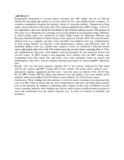| dc.contributor.author | Vodicka, E. | |
| dc.contributor.author | Babigumira, JB | |
| dc.contributor.author | Mann, M. | |
| dc.contributor.author | Kosgei, R.J | |
| dc.contributor.author | Lee, F | |
| dc.contributor.author | Mugo, N. | |
| dc.contributor.author | Okech, T | |
| dc.contributor.author | Sakr, S | |
| dc.contributor.author | [et al.] | |
| dc.date.accessioned | 2015-11-23T12:40:05Z | |
| dc.date.available | 2015-11-23T12:40:05Z | |
| dc.date.issued | 2015-07 | |
| dc.identifier.citation | Vodicka, E., Babigumira, JB, Mann, M. [untranslated] Kosgei, R.J [untranslated] Lee, F [untranslated] Mugo, N., Okech, T., Sakr, S., [et al. (2015). A cost-finding study of cervical cancer screening methods integrated into HIV care in Nairobi, Kenya. 8th IAS Conference on HIV pathogenesis, treatment and prevention,19 - 22 July 2015. TUPED813] | en_US |
| dc.identifier.uri | http://hdl.handle.net/11295/92645 | |
| dc.description.abstract | Background: Integration of cervical cancer screening into HIV clinics may be an efficient
method for decreasing the burden of cervical cancer in low- and middle-income countries. As
countries contemplate adopting this practice, choice of screening method - Papanicolaou (Pap)
smear, visual inspection with acetic acid (VIA), human papillomavirus (HPV) testing - will be of
key importance, and costs should be considered in the decision-making process. The purpose
of this study was to determine per screening costs of each method in an integrated setting.
Methods: A micro-costing study was conducted at Coptic Hope Center for Infectious Diseases
and Kenyatta National Hospital in Nairobi, Kenya from August to October 2014. We
assessed direct medical costs (e.g., supplies, provider visits) and direct non-medical costs
(e.g., transportation) of each testing method via interviews with administrative, clinical, and
laboratory staff. To determine indirect costs (e.g., patient time, caregiver costs), we conducted
a time-and-motion survey and patient interviews with 148 women receiving cervical cancer
screening (Pap or VIA), and supplementary interviews with patients receiving treatment for
pre-cancerous lesions and cervical cancer. As HPV testing is not frequently used, indirect costs
for HPV testing were extrapolated from Pap smear data and direct costs were calculated based
on clinical and administrative interviews, and on standard operating procedures for processing
HPV laboratory tests.
Results: VIA was the least expensive method ($11.17 per screen), followed by Pap smear
($16.32 per screen) and HPV testing ($25.19 per screen). Per-screen direct medical costs -
particularly supplies, equipment and lab costs - were the main cost drivers (VIA: $5.87; Pap:
$11.28; HPV testing: $20.16). Direct non-medical costs and indirect costs were similar across
methods (direct non-medical: $2.65-$2.84 per screen; indirect: $2.19-$2.65 per screen).
Conclusions: These findings provide estimates of cervical cancer screening costs integrated
into care in an HIV clinic in Kenya that are more comprehensive and more up-todate
than currently exist in the literature. In addition to informing policy makers on the costs of
different cervical cancer screening methods, these findings may also be used in future costeffectiveness
analyses to assess the incremental cost per clinical outcome (e.g., in terms of
reduced of morbidity and mortality). | en_US |
| dc.language.iso | en | en_US |
| dc.publisher | University of Nairobi | en_US |
| dc.title | A cost-finding study of cervical cancer screening methods integrated into HIV care in Nairobi, Kenya | en_US |
| dc.type | Presentation | en_US |

